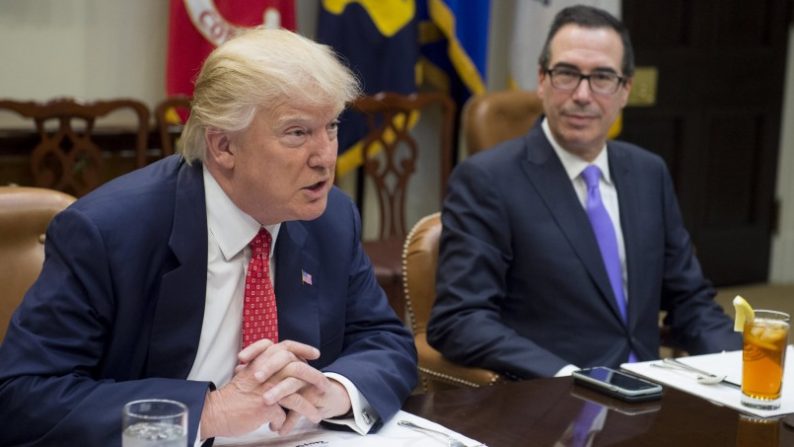Forecast
Analysis
The value of the U.S. dollar has risen rapidly over the past three years, up 26 percent since summer 2014. First, a divergence between the expected interest rates of the U.S. Federal Reserve and those of the world’s other central banks, namely the Bank of Japan and the European Central Bank, brought capital flooding into the United States. Two years later, Donald Trump’s election to the U.S. presidency gave the dollar another boost. And if his proposed tax reform package and infrastructure spending plan turn out to be as ambitious as Trump has promised, the dollar’s value may well keep on rising. A surging dollar, however, would have distinct drawbacks for the Trump administration, undermining the president’s stated goal to reduce the United States’ trade deficit. In fact, Trump has said the dollar is already too strong, and his economic team has accused other countries of undervaluing their currencies.

U.S. President Donald Trump (L) and Treasury Secretary Steven Mnuchin at a meeting on the federal budget in February. If the dollar resumes its dizzying ascent, Washington may look to coordinate a multilateral intervention. (SAUL LOEB/AFP/Getty Images)
Since January, the dollar’s rise has slowed a bit, in part because of Trump’s criticism and in part because of questions about his fiscal plan. But if the greenback resumes its dizzying ascent, the U.S. government may start looking at ways to rein it in. The Trump administration’s first resort would probably be a unilateral intervention. After all, currency decisions are left up to the secretary of the Treasury, who reports directly to the president — unlike monetary policy, which is the purview of the independent Fed system. The Treasury could print more dollars and use them to buy foreign currencies, a strategy that would drive the dollar’s value down, at least at first. The academic literature on the matter suggests, however, that the approach would not yield lasting results. A longer-lasting move would be to coordinate a multilateral intervention, a technique that has fallen out of fashion in the past two decades. The global economy undertook such an initiative most famously in 1985, when the United States, Japan, West Germany, France and the United Kingdom signed the Plaza Accord. And though the economic parallels between then and now might inspire the U.S. government to try to orchestrate a modern-day Plaza Accord, the task would be far more difficult today than it was the first time around.
Acting Accordingly
When Ronald Reagan assumed the presidency in 1981, the U.S. economy was moribund. To revive it, he introduced tax cuts and a deregulation campaign, while Fed Chairman Paul Volcker took interest rates to unprecedented heights in an effort to beat back inflation. The result was a staggering 45 percent rise in the dollar’s value from 1980 to 1985. The dollar’s might prompted talk of protectionist measures in Congress, which, in turn, encouraged the United States’ main trade partners to come together in September 1985 at New York’s Plaza Hotel to negotiate a joint solution with the United States. During the meeting, the central banks of the five countries involved agreed to coordinate interventions in the currency markets until the dollar had depreciated by 10 percent. And so the Plaza Accord was born.











Leave A Comment